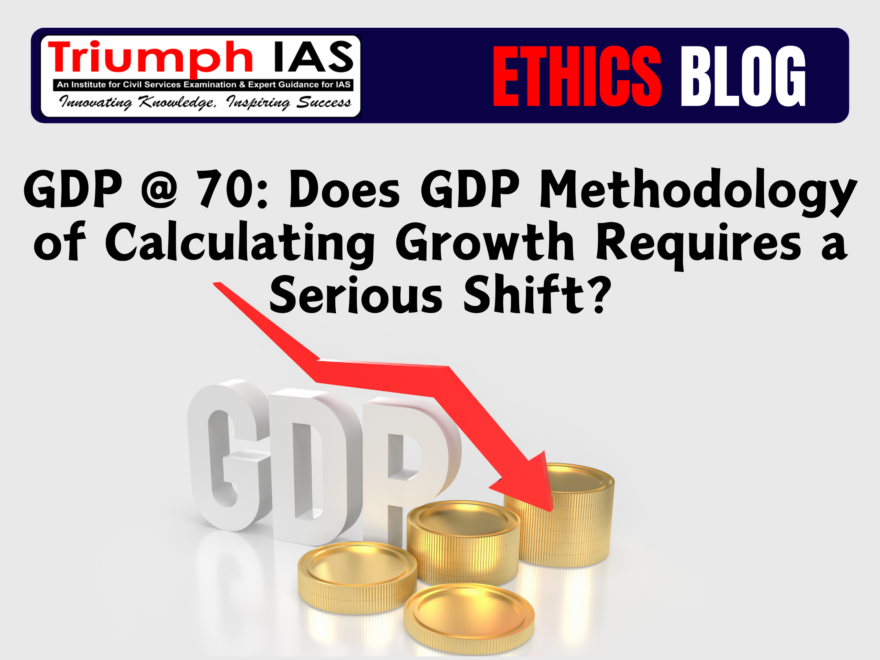GDP @ 70: Does GDP Methodology of Calculating Growth Requires a Serious Shift?
[Relevant for Public Ethics, Integrity and Aptitude]

GDP @ 70: Does GDP Methodology of Calculating Growth Requires a Serious Shift?
Researchers advocating reform of the world’s main measure of growth have an opportunity to participate in the process that sets the rules.
Is ‘sustained’ economic growth compatible with ‘sustainable’ economic growth?
Architects of the United Nations Sustainable Development Goals (SDGs) clearly thought so — both sustained and sustainable growth are mentioned in the 8th of the 17 SDGs.
But researchers focused on sustainability are increasingly questioning whether growth can continue indefinitely. Unless this debate can be settled, the ambition of SDG 8 to align economic and environmental policy is unlikely to be achieved.
For decades, influential economists, central banks and financial institutions have regarded continuous economic growth, measured in terms of gross domestic product (GDP), as essential to national prosperity. But along the way, many researchers have questioned whether endless growth is benign for the planet. An early voice was Herman Daly, who died last year (read 2023).
Almost 50 years ago, Daly wrote in one of his signature texts, Steady-State Economics (1977), that “the verb ‘to grow’ has become so overladen with positive value connotations that we have forgotten its first literal dictionary denotation, namely, ‘to spring up and develop to maturity’”.
Going “Beyond GDP”
Daly inspired a generation of researchers in the field of ecological economics. They are now among the leaders of a movement called Beyond GDP, which is drawing the world’s attention to the problems of adopting a single index as a proxy for prosperity, and the need instead to consider a dashboard of indicators such as the SDGs.
Beyond GDP is now being championed by UN secretary-general António Guterres, who has made it one of his priorities for his second term. And in May 2024, the European Parliament hosted a major conference at which researchers and policymakers discussed how the European Union can move beyond growth by integrating social and climate justice, equality and planetary boundaries into economic policymaking.
According to the agreed indicators for SDG 8, the goal is a long way from being met. The target of 7% annual GDP growth for the least-developed countries — the ‘sustained’ portion of the goal — is a distant prospect.
Growth rates for these countries are forecast to hover at just above 4% this year, after being much lower during the COVID-19 pandemic.
Meanwhile, the ‘sustainable’ part of SDG 8 — as measured by the quantity of raw materials needed to meet consumption demands — is heading in the wrong direction. Although a number of high-income countries have been able to decouple growth rates from carbon emissions, the global material footprint is showing no signs of coming down. It is increasing at a greater rate than both population and GDP.
Here, all sides of the growth debate need to engage with each other’s arguments, and on the basis of the evidence. There is currently an opportunity to do so through the international process for revising the methodology that determines what is measured by GDP.
Growing pains
GDP can be measured in several ways. Under one common definition, GDP is calculated by adding together consumer spending, what governments and businesses spend and invest, and exports minus imports. If SDG 8 requires GDP to increase continually, that conflicts with any incentive for governments to reduce their material footprint or carbon emissions, because these and other harmful activities have a positive effect on GDP. As the economist Kate Raworth writes in her 2017 book, Doughnut Economics, “We have economies that need to grow, whether or not they make us thrive; what we need are economies that make us thrive, whether or not they grow.”
There could, however, be a way to reconcile the twin goals of SDG 8. What goes into GDP isn’t set in stone. It is governed by rules that are set by an assembly of the world’s national statistical offices, organized through the UN. Revisions don’t happen often — there have been only 5 in the GDP formula’s 70-year history. The most recent was in 2008. Talks on the next one are under way, and are expected to be concluded by March 2025.
This revision to what is called the System of National Accounts (SNA) will differ from past revisions, partly because researchers are more involved. However, their engagement is still a fraction of that seen in many other UN processes. For example, scientists played a central part in the inception, implementation and monitoring of the SDGs, in the Paris climate agreement and in the UN’s rules and guidelines on environmental accounting.
UN-mediated agreements are open processes in which researchers and other observers can engage. They can, for example, comment on documents — the UN Statistics Division, based in New York City, which is administering the SNA revision talks, is publishing the working papers that will feed into the final text. These documents are organized by expert working groups on topics such as how to improve accounting for sustainability and well-being, and how to accurately put a value on the digital economy. The UN’s Network of Economic Statisticians has a calendar of online outreach events that researchers can sign up to join.
Researchers are among the most passionate advocates of moving beyond GDP. The SNA revision offers them a chance to take this advocacy to the centre of decision-making and to engage with the economists and statisticians responsible for setting the rules. Change won’t happen overnight, but, unless more researchers engage with those who advocate sustained growth and those who set the rules that define growth, it is unlikely to happen at all.
#EthicsBlogoTerms
Related Blogs …
 |
 |
Follow us :



Find More Blogs…
| Compare and contrast Karl Marx’s and Max weber’s | Karl Marx- Historical Materialism |
| Position of Women In the Modern Indian Society | Sociology: Social system and pattern variables |



One comment